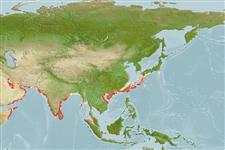分类 / Names
俗名 | 同种异名 | Catalog of Fishes(属, 种) | ITIS | CoL | WoRMS | Cloffa
Elasmobranchii
板鳃亚纲 (鲨鱼与 鱼) (sharks and rays) >
Rhinopristiformes (Shovelnose rays) >
Rhinidae (Wedgefishes)
Etymology: Rhynchobatus: Greek, rhingchos = snout + Greek, batis, -idos = a sting ray (Raja sp.) (Ref. 45335).
More on authors: Bloch & Schneider.
Environment: milieu / climate zone / depth range / distribution range
生态学
海洋 居于水底的; 深度上下限 0 - 60 m (Ref. 106604). 亞熱帶的; 35°N - 4°N, 49°E - 142°E (Ref. 114953)
Indo-West Pacific: Oman to Japan; mainly in the Indian Ocean.
西北太平洋: 已知來自模式標本產地, 明顯地是日本。
大小 / 重量 / 年龄
Maturity: Lm ? range ? - 130 cm
Max length : 270 cm TL 雄鱼/尚未辨别雌雄; (Ref. 106604); 最大体重: 240.0 kg (Ref. 114953)
A benthic species mainly found near the coast in shallow bays and off river mouths. It is poorly known but probably feeds on bottom-dwelling crustaceans and fishes (Ref. 114953). Ovoviviparous (Ref. 50449).
卵胎生的.(参考文献 50449)
Life cycle and mating behavior
成熟度 | 繁殖 | 产卵场 | 卵 | 孕卵数 | 仔鱼
Exhibit ovoviparity (aplacental viviparity), with embryos feeding initially on yolk, then receiving additional nourishment from the mother by indirect absorption of uterine fluid enriched with mucus, fat or protein through specialised structures (Ref. 50449).西北太平洋: 已知來自模式標本產地, 明顯地是日本。
Compagno, L.J.V., 1999. Checklist of living elasmobranchs. p. 471-498. In W.C. Hamlett (ed.) Sharks, skates, and rays: the biology of elasmobranch fishes. Johns Hopkins University Press, Maryland. (Ref. 35766)
世界自然保护联盟红皮书 (Ref. 130435: Version 2024-1)
极度濒危 (CR) (A2bd); Date assessed: 03 December 2018
人类利用
工具
特别资料
下载 XML
网络资源
Estimates based on models
Phylogenetic diversity index (Ref.
82804): PD
50 = 0.5049 [Uniqueness, from 0.5 = low to 2.0 = high].
Bayesian length-weight: a=0.00372 (0.00163 - 0.00845), b=3.11 (2.91 - 3.31), in cm total length, based on LWR estimates for this (Sub)family-body shape (Ref.
93245).
营养阶层 (Ref.
69278): 3.6 ±0.6 se; based on size and trophs of closest relatives
回复力 (Ref.
120179): 低的, 最小族群倍增时间4.5 - 14 年 (Fec assumed to be <100).
Fishing Vulnerability (Ref.
59153): Very high vulnerability (90 of 100).
